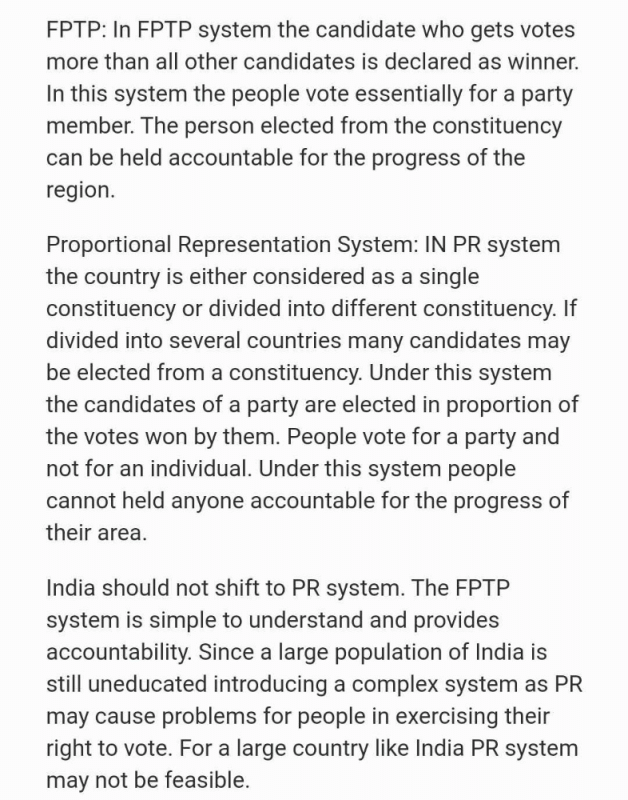Humanities/Arts Exam > Humanities/Arts Questions > What is the difference between FPTP and PR?
Start Learning for Free
What is the difference between FPTP and PR?
Most Upvoted Answer
What is the difference between FPTP and PR?

Community Answer
What is the difference between FPTP and PR?
FPTP vs PR: Understanding the Differences
First-Past-The-Post (FPTP)
- FPTP is a voting system where the candidate with the most votes wins the election.
- Voters have one vote, and they cast it for their preferred candidate.
- In FPTP, the country is divided into constituencies, and each constituency elects one representative to parliament.
- The party with the most representatives in parliament forms the government, and the leader of that party becomes the Prime Minister.
- FPTP is used in countries like the United Kingdom, the United States, and Canada.
- The winner-takes-all system in FPTP often leads to a two-party system.
Proportional Representation (PR)
- PR is a voting system where political parties are awarded seats in parliament based on the percentage of votes they receive.
- Voters cast their vote for a political party rather than an individual candidate.
- The number of seats a party receives is proportional to the number of votes they receive.
- PR is used in countries like Germany, New Zealand, and Sweden.
- PR encourages the formation of multiple political parties and leads to a more diverse parliament.
- PR ensures that smaller parties are represented in parliament, which can lead to a more democratic society.
Key Differences between FPTP and PR
- FPTP is a winner-takes-all system, while PR is a proportional system.
- In FPTP, voters cast their vote for an individual candidate, while in PR, voters cast their vote for a political party.
- FPTP often leads to a two-party system, while PR encourages the formation of multiple political parties.
- FPTP can lead to a government that does not reflect the diversity of the society it represents, while PR ensures that smaller parties are represented in parliament.
Conclusion
In conclusion, FPTP and PR are two very different voting systems that have a significant impact on the political landscape of a country. FPTP often leads to a two-party system, while PR encourages the formation of multiple political parties. PR ensures that smaller parties are represented in parliament, which can lead to a more democratic society. Ultimately, the choice between FPTP and PR depends on the values and priorities of a society and the political system they wish to create.

|
Explore Courses for Humanities/Arts exam
|

|
Similar Humanities/Arts Doubts
Question Description
What is the difference between FPTP and PR? for Humanities/Arts 2025 is part of Humanities/Arts preparation. The Question and answers have been prepared according to the Humanities/Arts exam syllabus. Information about What is the difference between FPTP and PR? covers all topics & solutions for Humanities/Arts 2025 Exam. Find important definitions, questions, meanings, examples, exercises and tests below for What is the difference between FPTP and PR?.
What is the difference between FPTP and PR? for Humanities/Arts 2025 is part of Humanities/Arts preparation. The Question and answers have been prepared according to the Humanities/Arts exam syllabus. Information about What is the difference between FPTP and PR? covers all topics & solutions for Humanities/Arts 2025 Exam. Find important definitions, questions, meanings, examples, exercises and tests below for What is the difference between FPTP and PR?.
Solutions for What is the difference between FPTP and PR? in English & in Hindi are available as part of our courses for Humanities/Arts.
Download more important topics, notes, lectures and mock test series for Humanities/Arts Exam by signing up for free.
Here you can find the meaning of What is the difference between FPTP and PR? defined & explained in the simplest way possible. Besides giving the explanation of
What is the difference between FPTP and PR?, a detailed solution for What is the difference between FPTP and PR? has been provided alongside types of What is the difference between FPTP and PR? theory, EduRev gives you an
ample number of questions to practice What is the difference between FPTP and PR? tests, examples and also practice Humanities/Arts tests.

|
Explore Courses for Humanities/Arts exam
|

|
Signup to solve all Doubts
Signup to see your scores go up within 7 days! Learn & Practice with 1000+ FREE Notes, Videos & Tests.



























